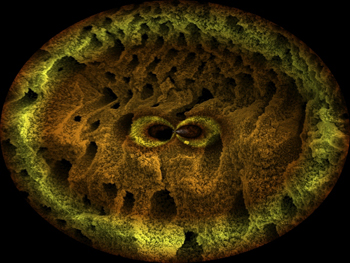Wednesday, February 28, 2007
Picture of the day
From NanoArt 2006. © Copyright Rense Andries Posthumus (click to see larger version)
NANOART is a new art discipline related to micro/nanosculptures created by artists/scientists through chemical/physical processes and/or natural micro/nanostructures that are visualized with powerful research tools like Scanning Electron Microscope and Atomic Force Microscope.
NanoArt could be for the 21st Century what Photography was for the 20th Century. We live in a technological society, in a new Renaissance period, and there is no reason for Arts to stay away from Technology. NanoArt is the expression of the New Technological Revolution and reflects the transition from Science to Art using Technology.
See all of Rense Andries Posthumus' NanoArt 2006 entries here, or visit the artist's website.
Please contact me if you would like to submit an image. (rocky at bir-consulting.com)
Quote of the day
In computer simulation tests, Boris Yakobson and his colleagues at North Carolina State University subjected the stringlike nanotubes to extreme stresses. "We wanted to see how flexible or brittle they are," said Yakobson, "and found they're amazingly flexible, unusual for graphite, which in large scale seems brittle." In twisting, bending, compressing and putting the virtual nanotubes on the rack, the physicists showed the structures could be stretched by almost 30 percent without breaking. Theoretically, they were strong enough to create a thread able to sustain 150 GPa (gigapascals), equivalent to holding a 20-ton weight on a 1 millimeter thread.
Read the entire article at Omni Magazine.
Read the entire article at Omni Magazine.
Interview with Jennifer Fonstad
Back in august of 2004 I interviewed Jennifer Fonstad of Draper Fisher Jurvetson (DFJ) on investing in nanotechnology. The following is an excerpt from that interview.
RR: What is your definition of nanotechnology?
More than just a scale of measurement, nanotechnology harnesses and exploits the many unique characteristics of working at the nanoscale. The capacity to manipulate and control matter at the atomic level was driven by the development of tools such as the atomic force microscope (AFM). As more tools enable that manipulation, technologists across a wide spectrum of industries use these capabilities in truly unique and disruptive ways in their business.
RR: Overall, what do you like about nano as an investment area?
We see significant opportunity in materials science and in the manipulation of matter at the atomic scale. Catalyzed by critical tools such as the AFM and sequencing of the human genome, these advances promise to enable a host of new applications that are based on the often unique properties that are exhibited at such a small size. Carbon nanotubes, for example, are stronger than steel, highly conductive, and are precisely ordered. Far from being scientific curiosities, these structures may enable a new generation of nonvolatile memory, which is the focus of one of our portfolio companies, Nantero.
Read the entire interview here
RR: What is your definition of nanotechnology?
More than just a scale of measurement, nanotechnology harnesses and exploits the many unique characteristics of working at the nanoscale. The capacity to manipulate and control matter at the atomic level was driven by the development of tools such as the atomic force microscope (AFM). As more tools enable that manipulation, technologists across a wide spectrum of industries use these capabilities in truly unique and disruptive ways in their business.
RR: Overall, what do you like about nano as an investment area?
We see significant opportunity in materials science and in the manipulation of matter at the atomic scale. Catalyzed by critical tools such as the AFM and sequencing of the human genome, these advances promise to enable a host of new applications that are based on the often unique properties that are exhibited at such a small size. Carbon nanotubes, for example, are stronger than steel, highly conductive, and are precisely ordered. Far from being scientific curiosities, these structures may enable a new generation of nonvolatile memory, which is the focus of one of our portfolio companies, Nantero.
Read the entire interview here
Subscribe to:
Comments (Atom)










